Reverend Rowland Koskamp
Heroic Reverend of The Third Reformed Church in Raritan was killed in World War II.
Reverend Koskamp was captured by the Germans at The Battle of The Bulge
In the POW camp he served as an inspirational leader as he kept up the morale of the men.
He was Awarded the Bronze Star
|
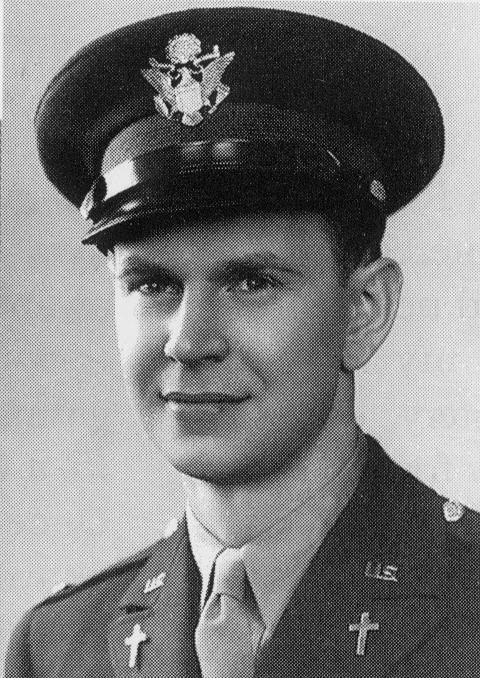 |
Last year the closing and selling of The Third Reformed Church in Raritan generated a good deal of controversy.
Many long term residents were heartbroken as it was Raritan’s first church whose origin went back to the 1850s. Therefore it is vital that its story
and that of its members be preserved.
One Reverend of the Third Reformed Church, Rowland Koskamp, who was killed in World War II has been forgotten even
though he has a quite an interesting and inspiring story. He volunteered to serve as an army chaplain overseas with the troops, earned the Bronze Star
as his unit fought their way across Europe, was taken POW, was liberated, then became a POW again, and tragically was later killed in the war. |
 |
 |
While his name appears on a memorial plaque in front of the Raritan Municipal Building there has
been little or no mention of him in any local history publications.
His name is even spelt wrong on the memorial plaque.
(Koskomp instead of Koskamp.)
However, during World War II, he was well known as his ongoing travels appeared numerous
times on the front pages of the local papers.
|
 |
 |
Rowland Koskamp, a native of Wisconsin, graduated from Western Theological Seminary in 1940. His first assignment, in September of 1940, was to go to Raritan to replace the retiring pastor of The Third Reformed Church. He brought with him his new wife Florence. In Raritan they would live at 62 East Somerset Street which then served as the rectory for The Third Reform Church. In 1942 Florence gave birth to a baby girl Karen Jane. He served as pastor until April 1943 when with World War II raging he decided he should be serving with the soldiers overseas on the front lines. He requested a leave of absence from the church to join the army as a chaplain. With his request was granted, he was shipped overseas to England and assigned to the 28th Infantry division. This unit would see plenty of combat. First, they landed at Normandy in July of 1944, one month after the massive U.S. landing that is known today as D-Day. They took up the struggle to move across France against stubborn resistance from the Germans. The terrain of France was dominated by thick bushes which covered the roadside. These bushes known as “hedgerows” gave cover to the defenders. This made each yard taken a difficult task. On their way toward Germany they would liberate many French towns. On August 29th 1944, they would parade through a liberated Paris to cheering crowds. However, their celebration would be short lived as the unit soon packed up and fought their way on further toward Germany. They arrived in Luxemburg in November of 1944. |
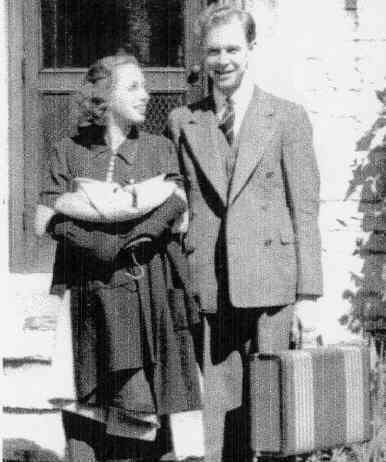 |
With his daughter Karen Jane.
She lives today in Michigan |
|
Rowland and his wife Florence |
 |
During his service Rowland would earn a promotion to Captain. Then in October of 1944 he was awarded The Bronze Star for his excellent service toward the men in his unit. The citation read “For meritorious service in connection with operations against the enemy from July 29 to October 3rd in France, Belgium, Luxembourg, and German. “ The 28th infantry needed his services as they had many casualties.
A part of a letter he had written home was printed on the front page of the local paper. It reflects his gentle nature, his dedication, and his ability to find humor in the insanity of war. It stated
“Our division is finally off the secret list so it can now be told that we’ve been in France, Belgium, Luxembourg, and German. We’ve hit the Siegfried Line and for two weeks I lived in one of the pill boxes on the line. What structures they are. Kind of cramped though for a two-week stay. Since that time I’ve established a rest camp for men of the battalion. I had a lot of fun with that and plenty of opportunity to serve the men in it. It was located in a schoolhouse. We served hot meals, gave them sleeping accommodations, movies, and opportunity to write letters. And above all, opportunity to attend services which was deeply appreciated by the majority of them.”
|
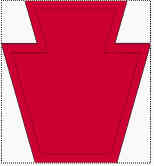 |
Click for Articles
about Koskamp |
|
The Logo For The 28th Infantry
was The Red Symbol Above
Click for details on the 28th |
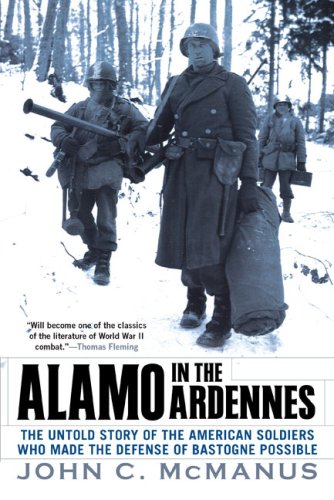 |
It is often said in war that there are no atheists in the foxholes. In another letter Reverend Koskamp wrote “I believe returning servicemen are going to be willing to give the church a hearing. Not 100 per cent of course, but in larger numbers than when they left home.”
While in Luxembourg they stayed in a schoolhouse that had been converted to an aid station. One of the other soldiers staying in the house with him happened to also be from Raritan - Joe Sansone from Gaston Avenue. On the morning of December 17th, 1944 the 28Th Infantry, like all of the U.S. forces, were caught off guard by a surprise German offensive. Koskamp and others were woken by the sounds of nearing artillery. The far off artillery fire gradually came closer and it started to shake the entire house. They did their part in this battle by going out and rounding up the wounded men and bringing them to the basement of the schoolhouse. This building was a good choice for an aid station as the cellar was reinforced with steel and concrete.
An assistant to Rowland Koskamp, Carl Montgomery, who would survive the war told about the battle in the 2005 book Alamo in the Ardennes by renown author John McManus. (It is interested to note that this story of a local Raritan Reverend in battle has been told in a popular book, but never told in Raritan.) The raging battle on the edge of this small village had not initially been a cause for an alarm. The Germans had supposedly been weakened to the point that the war would be ending very soon. Also, the 28th infantry had been taking on the Germans for months winning every battle. Carl Montgomery said that “They always had stopped them in their tracks before, and I had no reason to think they wouldn’t this time too.”
|
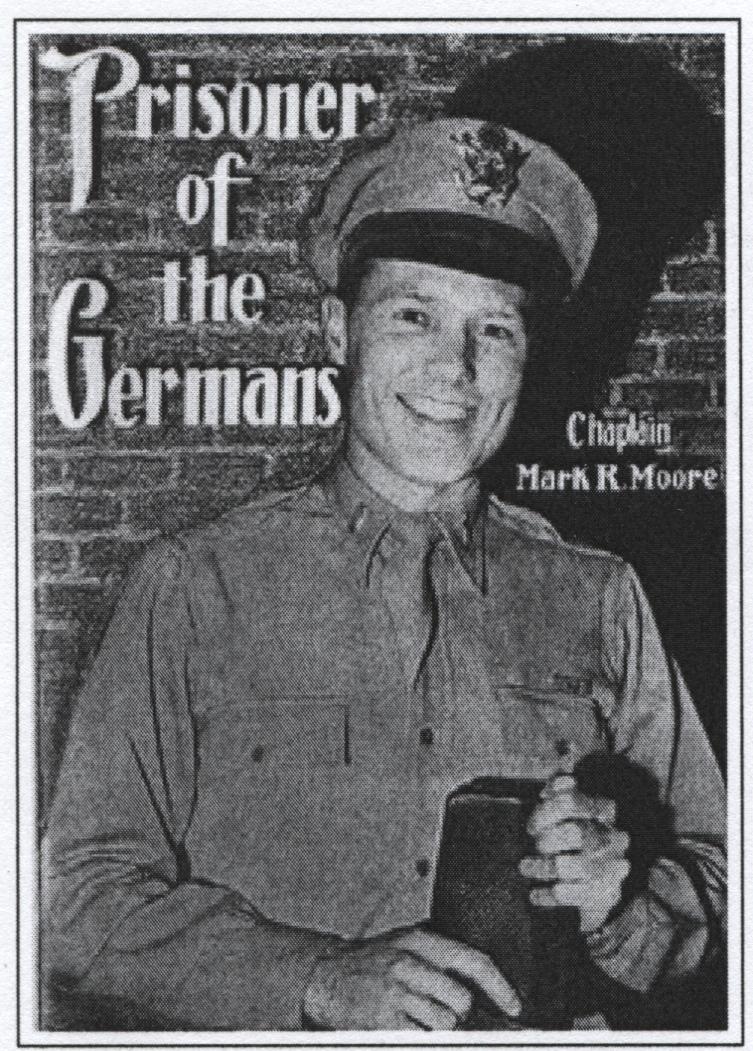 |
The book "Alamo in the Ardennes"
tells about Rowland Koskamp
during the battle where he
was taken prisoner. pages 110-111 |
|
A book by Mark Moore,
a chaplain who was also a POW,
has many references to
Reverend Koskamp |
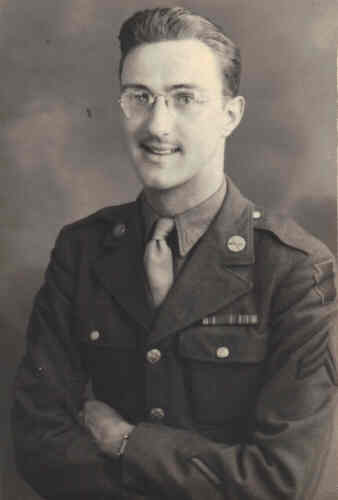 |
However, as the hours went by this battle was turning out to be very different. Later in the afternoon Carl Montgomery saw how the Germans were closing in and he tried to convince Reverend Koskamp to leave. However, the Reverend would not hear of it. They were caring for an ever growing number of wounded men in basement, giving them water, cigarettes (often given for comfort to the wounded in those days), and doing whatever they could for them. Carl Montgomery had been Koskamp’s assistant throughout the war thus he could not bring himself to leave him. Several of the soldiers had retreated to fight another day, but Koskamp, Montgomery, and Raritan’s Joe Sansone had chosen to stay with the wounded.
With the Germans closing in Reverend Koskamp and his unit had some reassurance when a US tank positioned itself right in front of the schoolhouse/ aid station. However, the U.S. tank quickly took a direct hit from a powerful shell. The tank blew up - the explosion ripped through one of the walls of the schoolhouse. Then a German tank started to fire directly into the building - pumping round after round into the schoolhouse until it was completely destroyed. They managed to avoid injury in the basement. When the barrage stopped, there was nothing left to do but hope to be able to surrender. Their story of how they surrendered was recounted by Raritan’s Joe Sansone , he said:
“Captain Koskamp went outside to talk to the German officer. He found the German could not speak English so he spoke to the officer in German or Dutch – I believe it was German, Captain Koskamp could make himself understood and could understand the officer.”
|
 |
Carl Montgomery -
Koskamp's Assistant
is still alive today (age 90)
He lives in New York City |
|
|
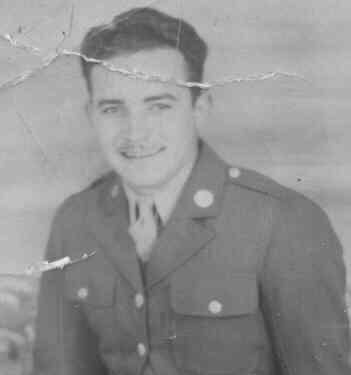 |
Thus they managed to surrender, never a guarantee in the brutality of war. The poor treatment they would receive as prisoners immediately became apparent as the Germans refused their request for them to grab their overcoats. During this battle, which is today known as The Battle of the Bulge, the Germans captured thousands of U.S. soldiers. Koskamp and Sansone were marched with 3000 others to a railroad station. Sixty men were put in each box car. Joe Sansone further went on tell about their first days as prisoner.
“We had no food all day the first day that we were captured. The next day we had bread and water. We had nothing on the third day. On Christmas we received English Red Cross boxes; five of us shared a box.”
An eight day train ride would take them to their POW camp. On their train ride to the prison at one point they were parked at a train stop when some U.S. planes circled around firing at the train. The German guards ran off till the attack was over - leaving the U.S. Prisoners locked in the box cars. Some of the prisoners were killed by this friendly fire. The Americans were obviously not aware that their own men were on this train. Reverend Koskamp would survive this round of friendly fire from the skies.
|
 |
Joe Sansone of Raritan
was taken prisoner
with Reverend Koskamp |
At the battle in Luxembourg Joe Sansone of Raritan stayed with Koskmap
to take care of the wounded. He would be taken POW.
Click to see articles and telegrams about Joe Sansone. |
Joe Sansone with his wife Rose.
They lived in Raritan
on Gaston Avenue |
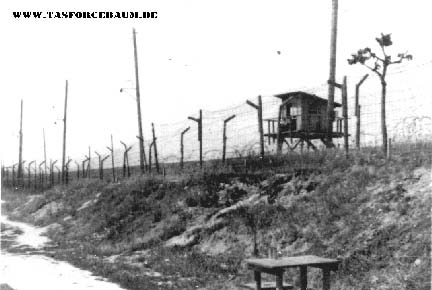 |
When they arrived at the POW complex the officers were separated from the enlisted men, and Koskamp and Sansone would part ways. At the officers POW camp, which was known as Hammelburg 13B (Oflag XIII-B), Rowland Koskamp took on the purpose of keeping moral up among the men. He did an excellent job. One survivor recalled “He was every man’s preacher. … He calmed the griper, supported the downer, let it be known that our present circumstance was only a temporary setback, and that there is a caring God who is concerned and offers eternity to those who call upon him.” Keeping busy in the camp is essential, yet often difficult as men have little strength for physical activity. One of the things that Rowland Koskamp did was to set up a Toastmasters Club where soldiers would learn to public speak to a group. Each speaker would share a story and those in attendance would evaluate the speaker on grammar and presentation style. These small activities would be vital to keeping moral high in the camp. Camp conditions were not good. The small amount of food they received was terrible. The average man would lose 30-40 pounds.
Another important function that Reverand Koskamp did inside the POW camp was to provide his fellow prisoners updated new reports on the war. As a chaplain he was often allowed to travel to different sections of the POW camp. In one section some Serbian officers had managed to hide a radio. When Koskamp visited their section they would update him on the news that they had gotten from the BBC in London. He would then pass this information along to the men in his section of the camp.
|
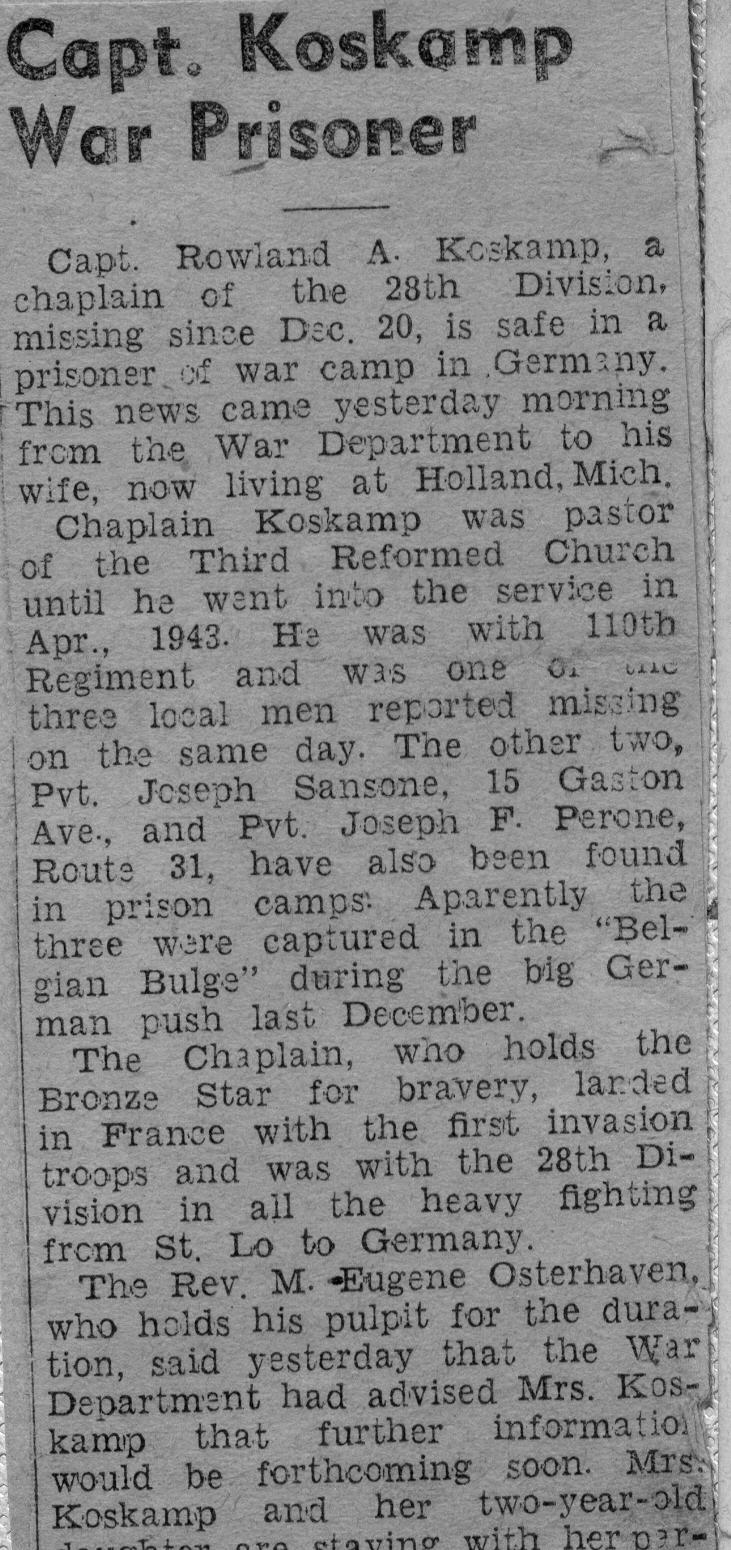 |
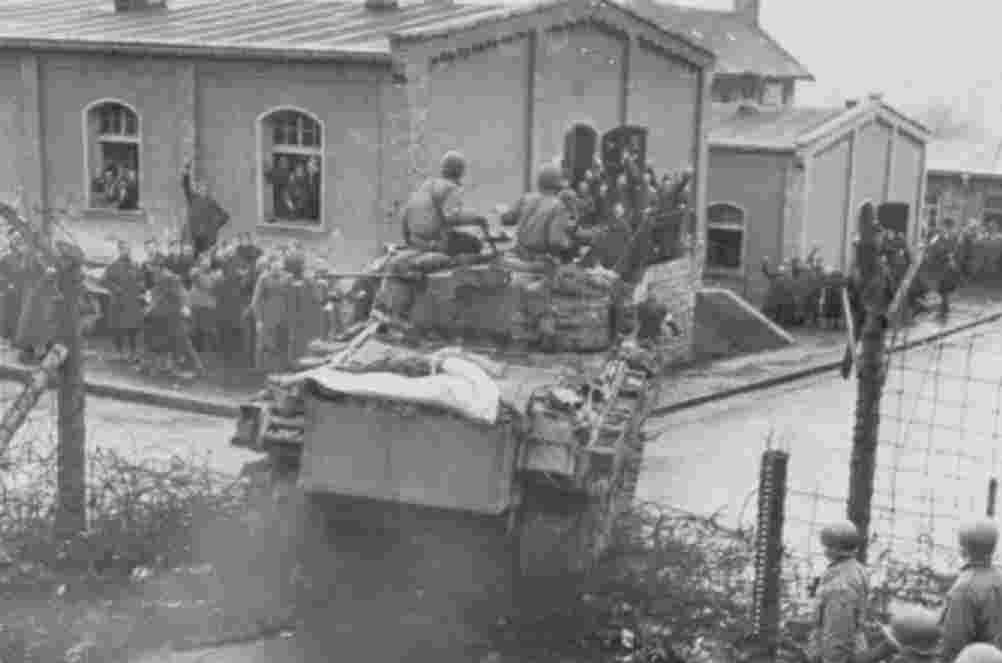 |
On March 27th 1945 after being prisoner for over three months, they were pleasantly surprised when a group of U.S. tanks broke through the fence of the POW camp. The German guards fled. (A few days before the U.S. army had broken through the German defenses at the Rhine River. A group of 200 men, with several tanks and vehicles were sent dashing forward 60 miles to liberate the POW camp.) The former prisoners quickly looted the German supply warehouse. They also killed and cooked several of the animals that were there for food. They ate to gain some strength and packed what supplies might be of aid to get back to the U.S. forces. Getting back to safety would still be a challenge. They were 60 miles from the bulk of the U.S. army and the rescuing group had over run their supply line. The escaped prisoners and their liberators along with the vehicles and tanks headed back to meet up with the U.S. Army. Still on enemy territory, with the war ravishing around them, they traveled that night. They had only traveled 10 miles when many tanks and vehicles started running out of gas. In the confusion of war they were not able to meet up with a fuel supply truck. The men held a conference to decide what to do. It was 50 miles to the Rhine River where the U.S. troops were. But it was just 10 miles back to the POW camp. They figured if they went back to the camp U.S. forces would probably liberate them in a few days. Most men decided to travel back to the POW camp. The simple shelter of the barracks could be lifesaving under the winter conditions. A prisoner returning to his POW camp after a brief futile escape was not all that rare. The Germans usually did not execute the returning prisoner. Others decided to attempt the 50 mile journey to the Rhine River. Some stayed at their location with the now stalled vehicles. Reverend Koskamp would return to the POW camp. When they returned to the camp their hope to be liberated in a few days was shattered as the Germans had regrouped, smartened up, and quickly took the U.S. prisoners on a 100 march toward a different POW camp in Nuremberg. |
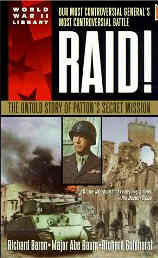 |
Click for Articles
on his POW Camp |
|
The Failed Rescue attempt is known as The Hammelburg Raid
books have been written about it
click for details |
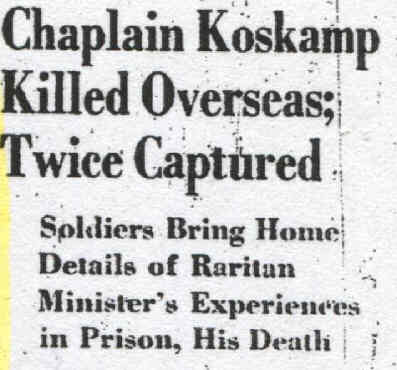 |
This was a dangerous time to be outside and exposed in Germany. The war was almost over. The U.S. Air Force had full control of the skies and was bombing German cities day and night. On April 5th Rowland Koskamp and the other prisoners were still on the forced march, yet coming near their destination of the POW camp in Nuremberg. His group saw numerous planes dropping bombs on the city of Nuremberg. At first they felt somewhat safe as they were a few miles from the center of the city where the bombs were falling. They were also in the woods. But soon they marched forward, always with guns pointed at them, and saw through the trees and across an open field that they were just a quarter of a mile from a railroad station. Unfortunately this railroad station was the target of the next load of bombs. (The U.S. had no intelligence reports to inform them that their own men were being marched to a new POW camp.) As the bombs rained down through the trees the men hit the dirt desperately trying for cover. However, there were many powerful bombs dropped from hundreds of planes by a U. S. Air Force that was determined to finish off the Germans. Around 30 Americans were killed in this bombing. Rowland Koskamp, Reverend of The Third Reform Church in Raritan, was one of them. |
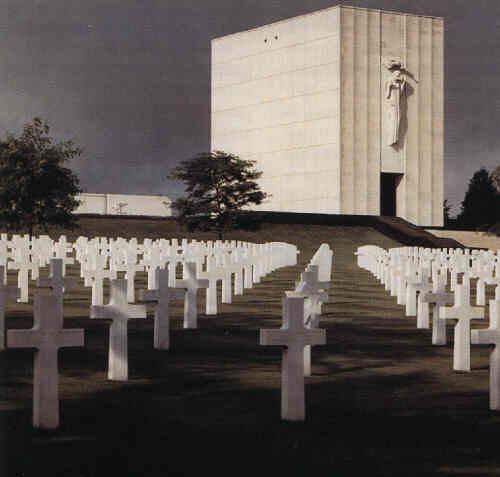 |
Click for Articles
about Koskamp |
|
He is buried in France
Click for details |
 |
Back on the homefront in Raritan, Reverend Koskamp’s ongoing travels had been tracked in the local papers. From his volunteering to go overseas, his promotion to Captain, his being awarded the Bronze Star, were all printed and read by the residents of Raritan. On December 20th, 1944 it was reported in the local Raritan paper that he was missing in action. In March 1945, hope was given when it was reported that he was a POW. In April 1945, his wife had received inaccurate news from a war department telegram that said he had been freed from the POW camp. Apparently some men liberated with him that had made it to freedom did not realize that Reverend Koskamp had gone back to the POW camp with many others. Thus, with the word from his wife, the local papers mistakenly reported that he was free. The Raritan community was looking forward to the return of their pastor who had served so well in the war. But then Rowland Koskamp’s wife Florence received another telegram toward the end of May, this one sadly accurate, that said her husband had been killed in action. She notified the new pastor of the Third Reformed Church in Raritan on a Saturday Night. The new pastor choose to announce the tragic news of Reverend Koskamp’s death at mass the next Sunday morning, May 27th, 1945. Those in attendance were shocked. They had last heard that Reverend Koskamp had been freed. And the war in Europe had ended over two weeks ago as Germany had surrendered on May 8th. No more casualties were expected from the war in Europe, but news traveled slowly in the 1940s. |
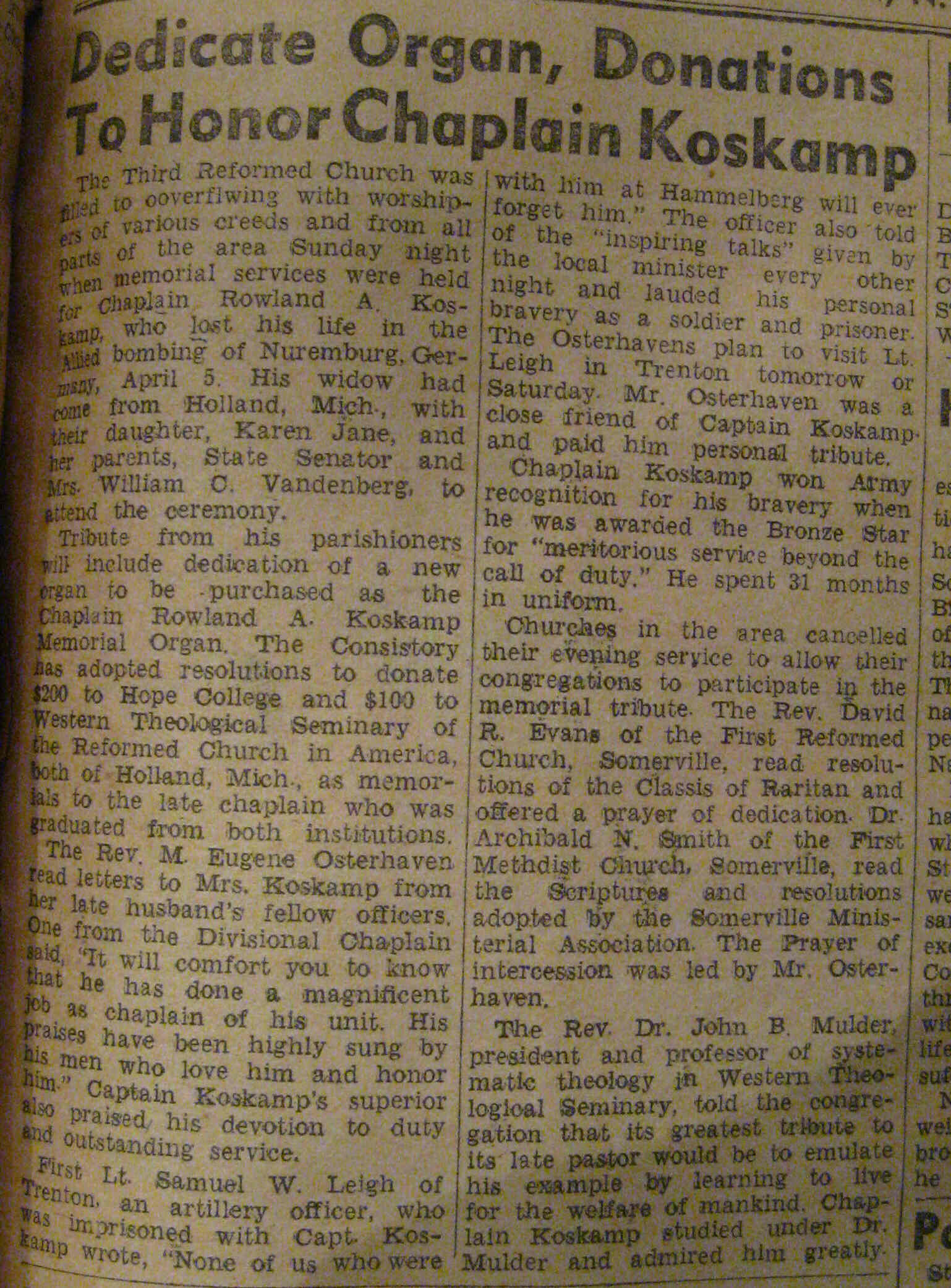 |
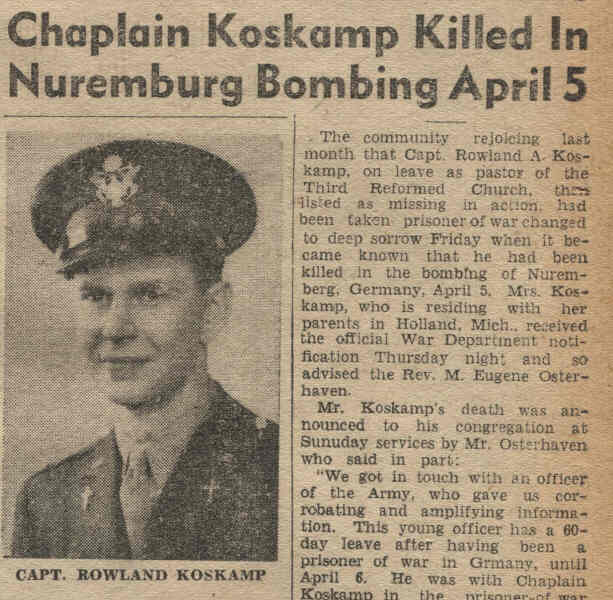 |
The Third Reformed Church held a memorial service to honor their fallen Reverend on Sunday, June 10th, 1945. The other Raritan churches made sure that no other activities were scheduled that evening so that there would be no conflicts for those that wanted to attend. Reverend Koskamp’s wife Florence and his daughter Karen Jane, now 2 years old, came from Michigan where they had been staying since Rowland had gone overseas. The church was overflowing with worshippers. At the service excerpts from some letters that were written by the men that served with Reverend Koskamp were read. One from his commanding officer stated “It will comfort you to know that he did a magnificent job as Chaplain of his unit. His praises have been highly sung by his men who love him and honor him.” Another officer who was in the POW camp with him wrote “None of us who were with him at the Hammelberg POW camp will ever forget him.” The letter went on to tell of the inspiring talks given by the minister and lauded his personal bravery as a soldier and prisoner.
Rowland Koskamp died serving his country. He could have stayed on the homefront as pastor of The Third Reformed Church in Raritan, but he choose to go overseas where he felt he could do the most good. He never regretted his decision. In one of his last letters that he wrote home he said “My work is proving most gratifying. I have never regretted my decision to enter it. I do however desperately long for the day when there will be no more opportunities for army chaplains and I can continue my work in a civilian parish.”
|
 |























